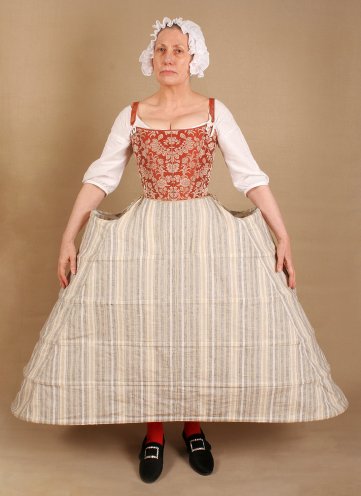 Hoop petticoats were fashionable for most of the 18th century from about 1710 till the 1780s; in England they were retained for Court wear till 1820.
Hoop petticoats were fashionable for most of the 18th century from about 1710 till the 1780s; in England they were retained for Court wear till 1820.
'Hoop' was the term usually used in England, regardless of the size or shape. The French term 'pannier' is often used in books of costume history, but it does not seem to have been used in England until the mid 19th century, when it became part of dressmakers' fashionable French terminology.
Accession Number: 69.208
Worthing Museum
The original of this hoop is in sandy-beige and blue striped linen and boned with cane hoops or 'rounds' as they were called in the 18th century. The cane rounds are surprisingly supple yet firm and have been bent into the required shape. Several of the rounds have become broken over the years and the hoop no longer presents a smooth shape.
Hoops could be referred to as 'short' or 'long'.
A square hoop could be short since the skirt simply fell from it in the same shape as the hoop.
A Fan hoop would be long since the skirt worn over it would need support lower down to keep the fan shape.
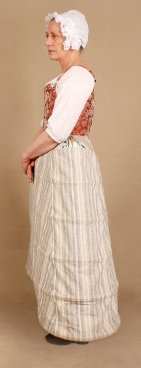
In making my version (right and above) I used steel boning with tape ties inside to hold the rounds into the narrow front to back style of the original.
Different sizes and shapes of hoop were fashionable during the century and also might gently slope out from the waist at front and back instead of being flat like this one.
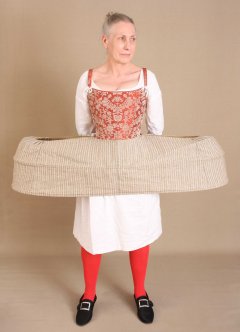
Accession Number: T425.1990
Victoria & Albert Museum
I was allowed to research this square hoop many years ago but until recently I have not been able to find boning strong enough to support its width. The original is preserved on a support mount so it was not possible for me to see the inside. I was able to take a pattern however and make a replica. Square hoops such as this seem to have been particularly popular in the 1740s and 1750s although many today find them ugly. It was often the shape chosen for court wear since it displayed rich fabrics to good advantage.
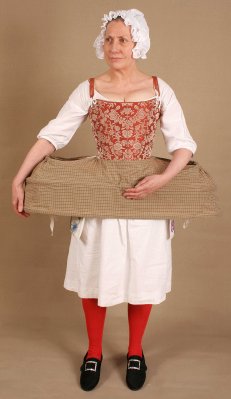
Although the hoop on the right is not copied from an original it is based on the shape of the large hoop shown above but made to a more everyday size.
This small square hoop could have been referred to as a 'two round hoop' in the 18th century or simply as a 'hoop'. Inventories often only list the number of hoops owned and unfortunately do not record their style or shape.
At the 'Stay and Petty-Coat Warehouse' in Norwich in 1743, Thomas Millner was selling, 'short Hoops with 3 Rounds at 2s. Ditto with 2 Rounds at 20d'.
Linen was the usual fabric used for hoops although Mrs Delaney writing in 1738 mentions expensive silk hoop petticoats trimmed with metal lace as being fashionable.
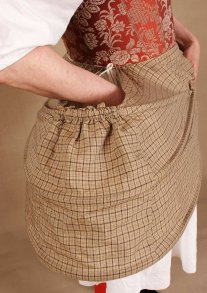
Several of the surviving hoops in England are made of pink and cream stripes or checks and this seems to be a popular choice. In 1745 William Millner of Norwich offered for sale, 'a large Parcel of Pink-colour'd-Hoops'.
In the above picture the lady's pockets can be seen peeping out below the hoop. Hoops usually fasten at the side with tie strings and are cut to allow access to the pockets worn underneath as may be seen here. To see more of pockets visit the Dressing the 18th Century Lady Page
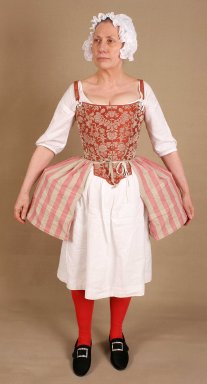
Pocket Hoops are the smallest size of hoop worn in the eighteenth century.
They consist of two linen shapes held out with bone or cane and tie about the waist. It is best when wearing pockets with pocket hoops to tie the pockets around the waist first and then put the pocket bag inside the hoop. This means you can still put your hand into the pocket and it helps to stabilise the hoop in wear. If you do not wear pockets but instead put things into the pocket hoops this can be disconcerting in wear as you feel them roll about.
Surprisingly there seem to be only about 3 pairs of pocket hoops surviving in British collections and only about a dozen hoop petticoats.
